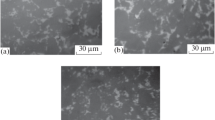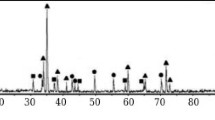Dense ceramic materials of silicon carbide with high mechanical properties are obtained by reaction sintering. The effect of different dispersed compositions of silicon carbide powders on the microstructure, grain size after sintering, and physical and mechanical properties is shown.

Similar content being viewed by others
References
G. G. Gnesin, Oxygen-free Ceramic Materials [in Russian], Tekhnika, Kiev, 1987, 152 pp.
G. G. Gnesin, Silicon-Carbide Materials [in Russian], Metallurgiya, Moscow, 1977, 216 pp.
A. P. Garshin, V. M. Gropyanov, G. P. Zaitsev, and S. S. Semenov, Engineering Ceramics [in Russian], Nauchtekhlitizdat, Moscow, 2003, 384 pp.
A. P. Garshin and S. G. Chulkin, Reaction-Sintered Silicon-Carbide Structural Materials. Physicomechanical and Tribotechnical Properties [in Russian], Izd. Politekh. Univ., St. Petersburg, 2006, 84 pp.
V. P. Paranosenkov, A. A. Chikina, and M. A. Andreev, “Structural materials based on self-bonded silicon carbide,” Ogneupory Tekh. Keram., No. 7, 37 – 40 (2006).
V. P. Paranosenkov, A. A. Chikina, and I. L. Shkarupa, “Selfbinding silicon carbide of OTM-923 grade,” Ogneupory Tekh. Keram., No. 2, 23 – 25 (2004).
A. P. Garshin, “Structure and properties of structural wear-resistant materials based on silicon carbide prepared by reactive sintering,” Doctoral Dissertation in Technical Sciences, St. Petersburg, 2000, 267 pp.
O. P. Chakrabarti, P. K. Das, and J. Mukerji, “Influence of free silicon content on the microhardness of RBSiC,” Ceram. Forum Int., 74(2), 98 – 101 (1997).
R. M. Fedoruk, V. V. Primachenko, L. K. Savina, et al., “Study of the effect of graphite additives and specific surface area of silicon on the thermal conductivity and other properties of reaction- bound silicon-carbide items,” Sb. Nauchn. Tr., Ukr. NIIO, 104, 31 – 36 (2004).
H. W. Kim, H. E. Kim, H. Song, and J. Ha, “Effect of oxidation on the room-temperature flexural strength of reaction-bonded silicon carbides,” J. Am. Ceram. Soc., 82(6), 1601 – 1604 (1999).
Q.-W. Huang and L.-H. Zhu, “High-temperature strength and toughness behaviors for reaction-bonded SiC ceramics below 1400°C,” Mater. Lett., 59(14/15), 1732 – 1735 (2005).
Zh. Lu, L. Ziong, J. Gao, and Zh. Jin, “Microstructure, porosity and resistivity in reaction-bonded silicon carbide,” Xi’an Jiaotong Daxue Xuebao, 33(4), 48 – 51 (1999).
P. Sangsuwan, J. A. Orejas, J. E. Gatica, et al., “Reactionbonded silicon carbide by reactive infiltration,” Ind. Eng. Chem. Res., 40(23), 5191 – 5198 (2001).
Y.-X. Wang, Sh.-H. Tan, and D.-L. Jiang, “The fabrication of reaction- formed silicon carbide with controlled microstructure by infiltrating a pure carbon preform with molten Si,” Ceram. Int., 30(3), 435 – 439 (2004).
E. Scafe, G. Giunta, L. Fabbri, et al., “Mechanical behavior of silicon-silicon carbide composites,” J. Eur. Ceram. Soc., 16(7), 703 – 713 (1996).
L. N. D’yachkova, E. V. Zvonarev, V. M. Shelekhina, and M. A. Isupov, “On reaction-sintering production of silicon carbide materials,” Inzh. Fiz. Zh., 70(2), 260 – 263 (1997).
V. P. Paranosenkov, A. A. Chikina, and M. A. Andreev, “Structural materials based on self-bonded silicon carbide,” Ogneupory Tekh. Keram., No. 7, 37 – 40 (2006).
V. P. Paranosenkov, A. A. Chikina, and I. L. Shkarupa, “Selfbinding silicon carbide of OTM-923 grade,” Ogneupory Tekh. Keram., No. 2, 23 – 25 (2004).
A. P. Garshin and S. G. Chulkin, Reaction-Sintered Silicon-Carbide Structural Materials. Physicomechanical and Tribotechnical Properties [in Russian], Izd. Politekh. Univ., St. Petersburg, 2006, 84 pp.
A. P. Garshin and Yu. N. Vil’k, “Effect of some technological parameters on structure formation in materials based on reaction- sintered silicon carbide,” Ogneupory Tekh. Keram., No. 8, 2 – 8 (1996).
Yu. N. Vil’k and A. P. Garshin, “Some properties of materials based on self-bound silicon carbide and the possibilities of their use,” Ogneupory Tekh. Keram., No. 7, 11 – 14 (1996).
S. N. Perevislov, “Evaluation of the crack resistance of reactive sintered composite boron carbide-based materials,” Refract. Ind. Ceram., 60(3), 168 – 173 (2019); Nov. Ogneupory, No. 3, 49 – 54 (2019).
S. N. Perevislov, A. S. Lysenkov, D. D. Titov, et al., “Production of ceramic materials based on SiC with low-melting oxide additives,” Glass Ceram., 75(9/10), 400 – 407 (2019).
M. G. Frolova, A. V. Leonov, Y. F. Kargin, et al., “Molding features of silicon carbide products by the method of hot slip casting,” Inorg. Mater.: Appl. Res., 9(4), 675 – 678 (2018).
S. N. Perevislov, A. S. Lysenkov, D. D. Titov, and M. V. Tomkovich, “Hot-pressed ceramic SiC–YAG materials,” Inorg. Mater., 53(2), 220 – 225 (2017).
A. S. Lysenkov, K. A. Kim, D. D. Titov, et al., “Composite material Si3N4/SiC with calcium aluminate additive,” J. Phys: Conf. Ser., 1134(1), 012036 (2018).
S. N. Perevislov, A. S. Lysenkov, D. D. Titov, et al., “Materials based on boron carbide obtained by reaction sintering,” IOP Conf. Ser.: Mater. Sci. Eng., 525(1), 012074 (2019).
M. A. Markov, S. S. Ordan’yan, S. V. Vikhman, et al., “Preparation of MoSi2–SiC–ZrB2 structural ceramics by free sintering,” Refract. Ind. Ceram., 60(4), 385 – 388 (2019); Nov. Ogneupory, No. 8, 34 – 37 (2019).
S. S. Ordan’yan, V. I. Rumyantsev, D. D. Nesmelov, and D. V. Korablev, “Physicochemical basis of creating new ceramics with participation of boron-containing refractory compounds and its practical implementation,” Refract. Ind. Ceram., 53(2), 108 – 111 (2012).
S. S. Ordan’yan, D. D. Nesmelov, D. P. Danilovich, and Y. P. Udalov, “Revisiting the structure of SiC–B4C–MedB2 systems and prospects for the development of composite ceramic materials based on them,” Russ. J. Non-Ferrous Met., 58(5), 545 – 551 (2017).
Author information
Authors and Affiliations
Corresponding author
Additional information
Translated from Novye Ogneupory, No. 4, pp. 41 – 45, April, 2020.
Rights and permissions
About this article
Cite this article
Perevislov, S.N., Markov, M.A., Krasikov, A.V. et al. Effect of SiC Dispersed Composition on Physical and Mechanical Properties of Reaction-Sintered Silicon Carbide. Refract Ind Ceram 61, 211–215 (2020). https://doi.org/10.1007/s11148-020-00458-4
Received:
Published:
Issue Date:
DOI: https://doi.org/10.1007/s11148-020-00458-4




